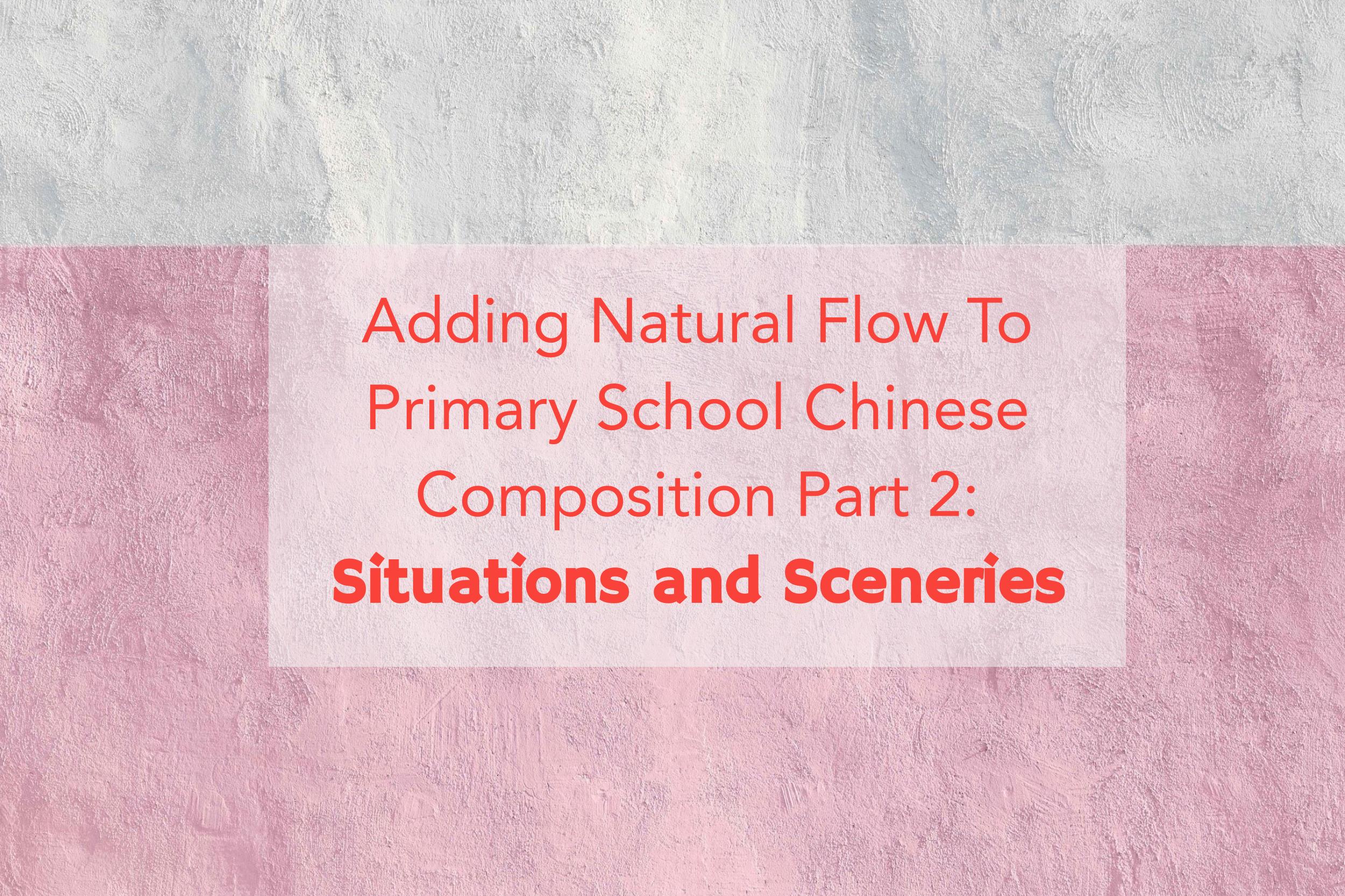Previously, we talked about the importance of a logical structure and strong characters to add a natural flow to primary school Chinese composition, which we hoped was helpful. In this article, we’re going to let you in on beloved tricks on how to add vitality to a situational composition (命题作文) and make your scenery-description skills sparkle.
Writing a good piece of situational composition
No matter how weak or strong your kid’s Chinese language skills are, digression is the worst mistake to make. Always remember: Have a clear purpose, and stay close to the title (and requirements if there are any) so the writing stays on track.
One elegant way to avoid deviation would be to include a framework consisting of the following 3 points:
- What happened?
- How did it happen?
- What happened in the end?
1. Details, details, details
Your readers will appreciate a little reality in your writing because it’s what helps resonate. Play with details—nothing expresses reality more deeply than adding little details here and there.
Here are the few key points on how to select those details:
- Choose accurate and authentic materials
- Pick a unique yet profound point of view
- Capture what triggers emotions

In a situational composition, students will be very likely to write about people, whether it’s the first person or third person. Lead readers to get as close to a character’s thoughts as possible, and to do that, pupils need to provide a little grounding to the character’s emotions. A close-up narrative allows readers to zoom in on the character’s train of thought, feel their discomfort and hear what they’re truly saying.
SIGN UP NOW: GET A FREE TRIAL LESSON AND LEARN HOW TO WRITE GREAT COMPOSITIONS
2. Clean and smooth writing
Students have the tendency to be naggy in their writings. What they should steer clear of is to drag on less if they’re trying to make a point.
Omit unnecessary adverbs, take away redundant details, and they’ve got to be sure where to start and where to stop. Start too late and the reader might lose interest. Stop too abruptly and the reader may find it awkward. Keep these pointers in mind to have a clean flow, clear structure, and stellar theme.

Tricks to write better on sceneries
Harry Potter would be less magical without the descriptions of the, well, magical castles and scenic landscapes, for example. Descriptions of sceneries, on top of a strong theme, adds mood, creates settings, and entertain readers. Let’s talk about how students can write about sceneries in their Chinese composition efficiently.
1. Add depth to descriptive using the ‘five senses’ method
Most pupils assume that once they’ve chosen a descriptive perspective and tense, their descriptive voice will take care of itself. Sadly, that’s not the case.
Writing scenery is, in fact, describing what we see, hear, taste, touch, and smell.
The next time students are writing, have them take note of the following:
- What can you see? Describe the colours and/or shapes.
- What can you hear? Is it loud, or muffled?
- What can you smell? Does it stink? Or does it smell good?
- What can you taste? Is it spicy, salty, sweet, sour or tasteless?
- What can you feel? Is it soft, furry, hot or cold?
When describing the scenery right, it unpacks the immersion experience and lets readers see the story for themselves.
For example,
坐在沙滩上,海水像个调皮的孩子,一会儿嬉笑跑过来,抱着你的脚撒娇或者故意使足了劲溅你一身水花,凉凉的、滑滑地像玉肌冰清的美人的手划过你的脸颊,带走夏日的炎热,让你生不起气来;一会儿又向远方跑去,任你怎么唤都不回头。
The above sentence uses the sight, hearing, and touch to liven an inanimate object, in this case, the sea, and also conveyed the writer’s love for the sea.

Showing always beats telling. Using the five senses in descriptive, or even narrative, writings evoke the right emotions or help make what’s already meaningful more profound.
2. Choose the right perspectives
Like a camera, your eyes see things in a certain way. There are two major perspectives, moving and fixed, to enliven the description of a scene. A moving perspective means the writer’s POV moves from scene to scene based on their movements, while a fixed perspective refers to a scene that’s fixed on the spot.
A great piece of article writing about a scenery changes perspectives using sentences to sentences or paragraph to paragraph. The exchange between the two methods elevates the depth of the scenery.
Confusing? Here’s an example:
前面就是那莽莽苍苍的大山,车在山麓上爬行,两旁是葱郁的树木,很放肆地长着,把一条十米宽的上山公路严严地护在中间。或许是第一次走这条山路,生疏的道路总是让人觉得特别的蜿蜒曲折和漫长,然而,也会有出其不意的惊讶。那些峰回路转的拐弯常常会使我们虚惊一场,路旁不时有一两间红砖黛瓦的房屋从眼前一晃而过,屋舍旁必定有几丛青翠的疏竹。车子风一般地掠过,那些竹叶便在车窗上噼啪作响,一路行来,倒也不寂寞。
3. Mix it up with action
Don’t bore readers with a full paragraph of scenic description, unless it’s used for other important purposes such as illustrating your character’s mood.
For instance, describe a beach. Instead of literally describing a boring beach scene, give the reader a clear sense of the area—if possible, mix it with action. Once the place is influenced by action, it feels mobile with a flicker of aliveness.
4. Show what you really want to convey

Good writers will, explicitly or subtly, introduce a place-as-character. For example, a dangerous man can be associated with a dark, sinister alley.
Whenever possible, make descriptions do double duty: for instance, use it to illustrate your character’s mood. People don’t want large chunks of descriptive writing. They want to be involved with the story and characters.
Conclusion
Whether it’s writing scenes, people or things, there’s no apparent boundaries on how to use them. For example, the ‘five senses’ method is a great principle for writing sceneries but is also superb when used for writing people. Students should learn to adopt these principles boldly and diligently when writing.
There is a lot in here, and mastering these tricks would take considerable effort and time. But if pupils could get to grips with them and become comfortable in applying them to a story, then they will have developed some impressively intricate writing skills. Maybe the better question is how students came around later. This practice always helps produce promising and complex pieces of writing.
Need professional help on teaching primary school Chinese composition to your kids? Our tutors are trained to engage students in the lessons where they’ll be able to produce promising and complex pieces of writing in time to come. Hurry and sign up for a free trial lesson now!
 Bonus:
Bonus:
For PSLE Chinese composition, there’ll be two options—命题作文 and 看图作文—for students to choose the one that they’d like to work on.
Planning before writing is crucial: here are some basic steps that students can follow before they start writing.
命题作文:
- Choose great idioms, phrases and vocab that you think will fit the theme
- Make sentences
- Glue everything together
看图作文:
- Look at the photos
- Choose great idioms, phrases and vocab that you think will fit the theme
- Make sentences
- Glue everything together
Also, we’ve included the past PSLE Chinese composition topics from the year 2000 to 2017 for your reference.









